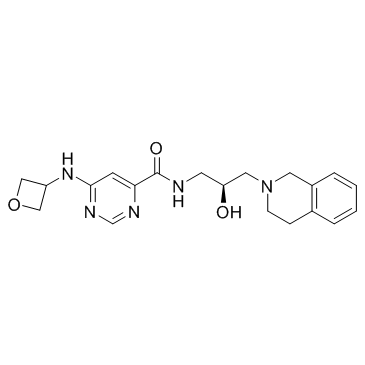| Description |
EPZ015666 is an orally available inhibitor of PRMT5 with an IC50 of 22 nM.
|
| Related Catalog |
|
| Target |
IC50: 22 nM (PRMT5)[1]
|
| In Vitro |
Treatment of MCL cell lines with EPZ015666 leads to inhibition of SmD3 methylation and cell death, with IC50 values in the nanomolar range[1]. EPZ015666, a potent peptide-competitive and SAM-cooperative inhibitor with >10,000-fold specificity against PRMT5 relative to other methyltransferases[2].
|
| In Vivo |
EPZ015666 is orally bioavailable and amenable to in vivo studies. We performed 21-d efficacy studies in severe combined immunodeficiency (SCID) mice bearing subcutaneous Z-138 and Maver-1 xenografts, with twice-daily (BID) oral dosing on four dose groups: 25, 50, 100 and 200 mg per kilogram of body weight (mg/kg). After 21 d of continuous dosing, animals are euthanized, and blood and tissues are analyzed to determine the relationship between methyl-mark pharmacodynamics and tumor-growth inhibition (TGI). EPZ015666 showed dose-dependent exposure and TGI after 21 d in both MCL models. Tumors in all EPZ015666 dose groups measured on day 21 showed statistically significant differences in weight, volume and tumor growth compared to vehicle-treated tumors. Dosing at 200 mg/kg BID induced tumor stasis in Z-138 cells, with >93% TGI after 21 d, whereas Maver-1 cells showed >70% TGI. Additionally, a third MCL xenograft is tested using the Granta-519 cell line, a fast-growing model that reached endpoint on day 18 and showed dose-dependent efficacy with 45% TGI in the 200 mg/kg group. EPZ015666 is well tolerated in all three models, with minimal bodyweight loss in the 200 mg/kg dose group and no other clinical observations[1].
|
| Kinase Assay |
EPZ015666 is serially diluted threefold from 1,000 to 0.051 nM and spotted into a 384-well polypropylene V-bottom microplate. 3H-SAM is serially diluted twofold in assay buffer for a seven-point dilution series with a top concentration of 700 nM (final assay concentration). Reactions are initiated by the addition of 4 nM enzyme and 40 nM peptide (final assay concentrations for both). Reactions are incubated for 60 min and quenched by the addition of 10 μL per well of 600 μM unlabeled SAM in assay buffer (final assay concentration). For the peptide competition, EPZ015666 is serially diluted threefold from 1,000 to 0.051 nM and spotted into a 384-well polypropylene V-bottom microplate. Peptide is serially diluted twofold in assay buffer for a seven-point dilution series with a top concentration of 480 nM (final assay concentration). Reactions are initiated by the addition of 4 nM enzyme and 75 nM 3H-SAM (final assay concentrations for both). Reactions are incubated for 60 min, and the reactions are quenched by the addition of 10 μL per well of 600 μM unlabeled SAM in assay buffer (final assay concentration)[1].
|
| Cell Assay |
Cultured cells in linear/log-phase growth are split to a seeding density of 2×105 cells/mL in 2-20 mL of media, depending on the yield required at the end of the growth period. Compound is diluted in DMSO and added to each culture vessel with a final DMSO concentration of 0.2%. Cells are allowed to grow for 96 h undisturbed. At the conclusion of each treatment period, cells are harvested by centrifugation (5 min, 1,200 rpm), and cell pellets are rinsed once with PBS before being frozen on dry ice pending further processing. Long-term proliferation assays are performed on all MCL lines, with slight adjustments to initial seeding densities, depending on growth characteristics for each cell line. All assays are carried out for 12 d[1].
|
| Animal Admin |
Mice[1] Male CD-1 mice (25-40 g; n=6, with 3 per time point) are treated with a single dose of EPZ015666 at 2 mg/kg by intravenous tail-vein injection and 10 mg/kg by oral gavage administration, with both doses formulated in 20% N-N-dimethylacetamide in water. Animals are fasted overnight and weighed before dose administration on the day of dosing. Approximately 30 μL of blood are taken from animals by submandibular or retro-orbital bleeding at pre-specified time intervals (seven time points). For the last time point (24 h), samples are collected via cardiac puncture while the animals are under anesthesia (70% CO2:30% O2). Blood samples are transferred into K2-EDTA tubes and placed on wet ice before centrifugation at 4°C (3,000g, 15 min) to obtain plasma within 30 min after sample collection. Plasma samples are stored at −70±10°C before protein precipitation and LC-MS/MS analysis. We constructed standard calibration curves by analyzing a series of control plasma aliquots containing 100 ng/mL labetalol as an internal standard and 1-3,000 ng/mL EPZ015666. Four levels of quality control are also included in the analysis (3-2,400 ng/mL EPZ015666). Data are analyzed using Phoenix WinNonlin 6.2.1.
|
| References |
[1]. Chan-Penebre E, et al. A selective inhibitor of PRMT5 with in vivo and in vitro potency in MCL models. Nat Chem Biol. 2015 Jun;11(6):432-7. [2]. Kryukov GV, et al. MTAP deletion confers enhanced dependency on the PRMT5 arginine methyltransferase in cancer cells. Science. 2016 Mar 11;351(6278):1214-8.
|
